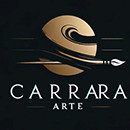Presentation of Giovanna Riu at the Roberto Tagliazucchi
expo at the Orangeries du Chateaux de SUCY EN BRIE
There are two different ways, equally important, of approaching an artist's works. One, historical and biographical, defines the artist in a cultural and social journey, through the characteristics of their environment and, in a broader sense, seeks to characterize them by their relationships with the artistic movements of their time. The other focuses more on the art object, on that art which is theirs and which, through a series of formal inventions, questions the universal meaning of art. The shift from one to the other is inevitable, thus reducing the work to the psychological characteristics of the artist becomes a habit. Our attention then turns away from the work, which, however, has its own existence, transcending the history and life of the author who, to give form to a mysterious core (dream, archetype, illusion of power), did everything in their power and used their extreme narcissism as a necessary instrument for their work. If there is a meeting point between these two visions of the work, it must be sought in the universal meaning assumed by the object when it transforms into art. It then encompasses that rare communicative "necessity," that shift in meaning which makes it recognizable, appreciable among the cultural models of the historical moment in which the artist lives and ultimately beneficial to all. However, meaning and significance are never crystallized, never defined. The sculptor Roberto Tagliazucchi, in his rare aesthetic statements, may cite Cubism and Futurism, decomposition and simultaneity, may elevate Brancusi to the rank of a totem of contemporary sculpture, he may still admire the essential nature of Moore's themes, but he will never fully, and fortunately, justify his total lack of homologation with trends, models, authors, academic rules... His special "science" allows him to make space dynamic, to absorb and reflect light, to freely enter and exit the object. The work, therefore, does not have a predominant side but offers a multitude of aspects, each being the "right" one at the precise moment it is observed. The artist can still tell his poetry through the metaphors, myths, and passions that stir him: he is a man of a fragile century, struggling with matter, an end of a century, tumultuous, where, amid true ruins, he attempts to make visible to himself what flees, tries the visionary enterprise of the journey from the real to the possible. His "humanism" becomes a figure whose contours retain some elements of the multiplicity of what, out of convenience, out of conformity, we call history, reality, environment. A very difficult task for one who is already the metamorphosis itself. The need for narrative and "literature" that we demand of art will forever prevent us from fully penetrating the lost or rediscovered paradise of SOGNANDO (Dreaming), the vitalism of NATHALIE, the ancestral correspondence of THE FLUTE PLAYER, the stubborn determination of DAVID. However, form and idea, the two inseparable souls of art, have found their harmony. In this exhibition, whose "crossing" leads us towards a predominantly Mediterranean soul, "the archetype of the earth" and "the archetype of the sky" are the obliged interpreters, one with sensuality, corporeality, dismemberment, grinding, the other with the sidereal, the absolute, the need for infinity. Between them, there is Eros, there is art and the knowledge of Roberto Tagliazucchi who made possible the "beauty" of contradiction.
January'98 Giovanna Riu, Art Critic
Presentation of Giovanna Riu at the Roberto Tagliazucchi expo at the Orangeries du Chateaux de SUCY EN BRIE


